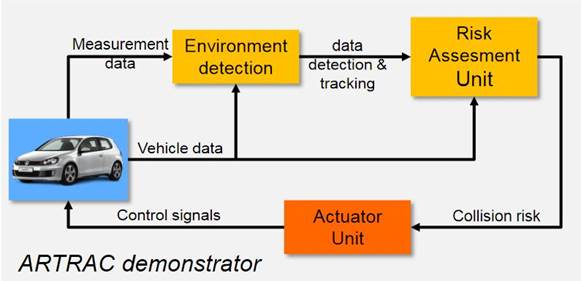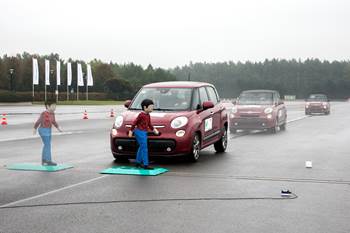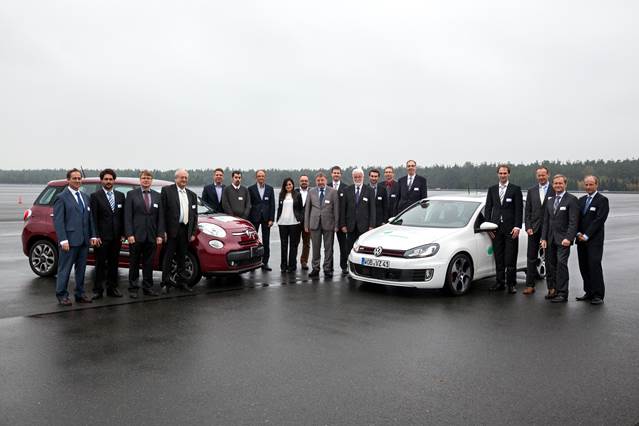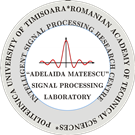 |
Goal of the project: ARTRAC aims to develop an active safety system to protect vulnerable road users (VRUs) from vehicles in motion that
is economically viable in the volume vehicle market. The safety system will consist of both actuators for controlling vehicle driving dynamics and the perception
component for the vehicle’s surroundings. It will be tested on two types of vehicles that pose the biggest hazard to VRUs in urban settings,
namely cars and light delivery goods vehicles.
|
Short description of the project: The environmental sensing used in ARTRAC project will be based on a single automotive 24 GHz narrowband radar sensor. This offers the potential to overcome the price barrier that has prevented VRU protection systems from entering widespread use. To meet the challenging technical requirements for very short measurement time, reliable target detection, ego motion and road condition estimation, a new transmit/receive antenna and multi-channel receiver will be developed.

ARTRAC demonstrator
Project implemented by: Consortium of seven institutions: 2 car manufacturers (VOLKSWAGEN, FIAT through CRF), 2 research organizations (VTT - Finland, CTAG - Spain), 2 universities (TUHH – Technical University Hamburg-Harburg, UPT – Timisoara), one SME specialized in car sensors (SMS Germany).
Implementation period: 2011.11 – 2014.10
Main activities
The whole system consisting of radar sensor, sensor fusion, risk assessment and vehicle control has a high potential to be launched because the majority of components is already standard equipment in series cars. Measures for VRU protection might be divided into passive and active systems. Because of basic physical properties, passive measures can provide limited protection potential only. Therefore (active) actuators are necessary to achieve the desired protection for VRUs. Vehicle deceleration seems to be a potential approach for active VRU protection with high benefit and high potential for high volume series cars, as they are already in use in high-end limousines.
The environmental sensing will be conducted with a novel high performance but low-cost 24 GHz narrowband radar system. From an operational viewpoint, this RF frequency fits exactly into the existing ISM band from 24,000 GHz to 24,250 GHz. Due to this techno-political feature this radar has a long term perspective on European and world-wide markets.
Results
ARTRAC addresses the following six major scientific and technical objectives:
- Develop a generic detection system able to detect pedestrians, cyclists, and other vulnerable road users (VRU) as well as vehicles.
- Implement the capability to monitor road surface conditions and detect low-friction road sections caused by water, ice or snow on asphalt, to warn or adapt the vehicle’s electronic control systems such as electronic stability control (ESC) and collision avoidance systems (CAS) for changed friction conditions.
- Promote the deployment of VRU safety technologies among relevant bodies and stakeholders, including end-users.
Studies and papers developed by UPT research team for ARTRAC project
- Ioan NAFORNITA, Andrei CAMPEANU, Alexandru ISAR, Corina NAFORNITA, Adrian MACAVEIU – “Rapid Chirps”, “Road Condition Measurements”, “Tracking” – April 2014
- Adrian Macaveiu, Andrei Campeanu, Ioan Nafornita, Kalman-Based Tracker for Multiple Radar Targets,10th International Conference on Communications, COMMUNICATIONS 2014, May 29-31, 2014, Bucharest,IEEE Xplore,2014, pp.69-72 , DOI 10.1109/ICComm.2014.6866690
- Adrian Macaveiu, Corina Nafornita, Alexandru Isar, Andrei Campeanu, Ioan Nafornita, A Method for Building the Range-Doppler Map for Multiple Automotive Radar Targets, International Symposium on Electronics and Telecommunications (ISETC), Timisoara, November 2014, 14-15 Nov 2014, 2014,pp.151-156
- Corina NAFORNITA, Adrian MACAVEIU, Alexandru ISAR, Ioan NAFORNITA, Andrei CAMPEANU, Envelope Detector with Denoising to Improve the Detection Probability, pp 59-64. May 29-31, 2014, Bucharest, 10th International Conf. on Communications, IEEE Xplore
- Adrian Macaveiu, Andrei Campeanu, Automotive radar target tracking by Kalman filtering, October 2013, Conference: Telecommunication in Modern Satellite, Cable and Broadcasting Services (TELSIKS), 2013 11th International Conference on, Volume: 02, DOI: 10.1109/TELSKS.2013.6704439
  
Final event at Proving Ground Ehra: ARTRAC road traffic scenarios testing involving VRU’s

ARTRAC team at the final event at Proving Ground Ehra, Volfswagen
Aplicability and transferability of the results
The key result of the ARTRAC project is a safety system that aims to protect vulnerable road users, designed to be economically viable in the volume vehicle market. The safety system consists of both actuators for controlling vehicle driving dynamics and the perception component for the vehicle’s surroundings. The ARTRAC detection system will be small, lightweight and economical in order to enable an easy integration in the vehicle design. More details: http://vimeo.com/111830073
Fields of interest: radar, sensor, vulnerable road users, protection, road condition detection, collision avoidance, assisted braking.
Research centre: Intelligent Signal Processing Research Centre (ISPRC)
Financed through/by: The project is 75% funded by the EU 7th Framework Program (FP7 No. 284740/2011 – 120.183 €) and 25% by the national Program PNII (contract 223EU/24.07.2013 –178.996,74 lei)
Research team: Prof. Dr. Eng. Ioan Nafornita, Prof. Dr. Eng. Alexandru Isar, Prof. Dr. Eng. Andrei Campeanu, Assoc. Prof. Dr. Eng. Corina Nafornita, PhD student Adrian Macaveiu.
Contact information
Prof.Dr. Ioan Nafornita
Bv. V. Parvan nr. 2. B219, 300223
Timisoara, Romania
Tel./Fax.: (0040) 256 403 302
e-mail: ioan.nafornita at upt.ro
web: http://www.artrac.org, http://www.tc.etc.upt.ro/isprc
|

